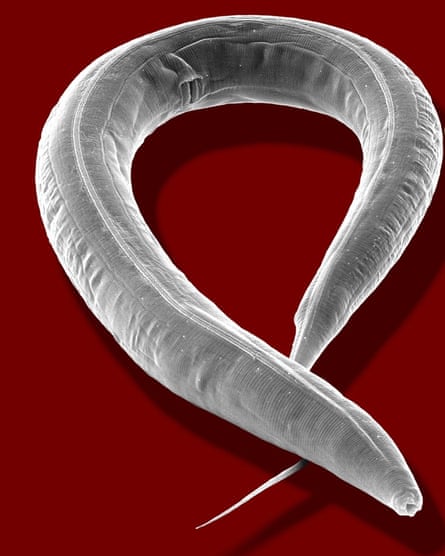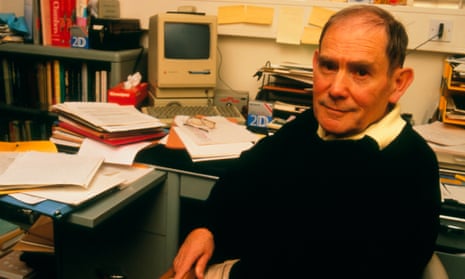When James Watson and Francis Crick first completed their model of the structure of DNA in April 1953, a group of Oxford scientists drove to the Cavendish Laboratory in Cambridge to see it. Among them was Sydney Brenner, a short, heavy-browed South African doctoral student in chemistry. The visit marked a watershed in his scientific life. “I just knew that this was the beginning of molecular biology,” he wrote later. “This was it … the curtain had been lifted and everything was now clear as to what to do.”
Brenner, who has died aged 92, went on to be a driving force in the molecular biology revolution of the late 20th century. His self-chosen mission to explore the genetics, development and behaviour of a tiny nematode worm led to critical insights into human disease. In 2002 that work brought him a share in the Nobel prize for physiology that many felt was long overdue.
An inventive experimenter, a visionary and a provocateur, he made many of his most important discoveries early in his career. However, throughout a scientific life that continued into his 10th decade, he stimulated thousands of others to develop new areas of research. While, with one exception, he fought shy of administrative leadership, he advised a number of key research organisations and initiatives.
Brenner was frequently labelled the “enfant terrible of molecular biology”; he could perhaps more accurately be described as its “eminence grise”. After meeting Crick in 1953, he joined him as soon as he could at the Medical Research Council (MRC) molecular biology research unit (later the Laboratory of Molecular Biology, LMB) in Cambridge. They shared an office for 20 years, talking non-stop, laughing uproariously and generating hundreds of ideas, which they tested in the laboratory with their indispensable research assistant Leslie Barnett. She remained a close colleague of Brenner’s until long after he had left Cambridge.
Watson and Crick had grasped that the sequences of nucleotide bases in the DNA molecule – the As, Cs, Gs and Ts – somehow encoded the sequences of amino acids in proteins. In 1961 Crick, Brenner and their assistants were the first to prove that the code for each of the 20 amino acids was a sequence of three bases, known as a triplet codon.

The same year, working with the French biologist François Jacob and the US geneticist Matthew Meselson, Brenner proved the existence of a “messenger” – a short-lived RNA transcript of the DNA sequence that directs the cell’s production of amino acids. Armed with these two concepts – the triplet code and the messenger – molecular biologists around the world could begin to complete the molecular puzzle of linking each DNA or RNA triplet to a specific amino acid or “stop” signal.
By 1966 the code was fully cracked, but Brenner had already moved on from molecules to whole animals. He needed an organism that was extremely simple, yet possessed of a nervous system and able to sense, move and reproduce in a way that was easy to study in the lab. The plan was to make mutant forms of the organism so that he could establish how genes controlled development and behaviour.
He chose Caenorhabditis elegans, a microscopic worm with only 959 cells in the adult, which breeds quickly and is easy to keep. Brenner recruited a team of researchers from diverse backgrounds to undertake the task of describing C elegans completely. Nicol Thompson and John White used electron microscopy and computer reconstruction to draw a complete wiring diagram of the worm’s nervous system. John Sulston and Robert Horvitz (who shared the 2002 Nobel prize with Brenner) traced the lineage of every cell in the worm from fertilised egg to adult, and discovered how some cells are programmed to die. Sulston, with Robert Waterston at the Washington University in St Louis, went on to map and sequence the entire worm genome.
Brenner left his troops pretty much to themselves while he threw himself into learning to program the advanced (for its time) computer he had managed to persuade the MRC to buy for the lab. Visiting scientists went back to their home institutions and started new labs, so that today there is a community of worm researchers all over the world: the task Brenner set them is still unfinished. “I’ve always found it interesting to bring projects to the stage that other people can take them over and develop all the little tricks,” he wrote.
Born in Germiston, near Johannesburg, Sydney was the son of Morris, an illiterate Jewish immigrant from Lithuania who worked as a shoemender, and his wife, Lena (nee Blacher), who came from Latvia. A neighbour taught the boy to read, and a customer of his father’s provided him with a free kindergarten place. Insatiably curious, Sydney was largely self-taught from the local library, and progressed so rapidly through school that he obtained a bursary to read medicine at the University of the Witwatersrand when he was 15.
Because he would still be too young to practise medicine by the time he finished the course, he took a diversion into research for a master’s degree, which he described as “heaven”. Although he did eventually qualify in medicine, he immediately applied for a scholarship from the Royal Commission for the Exhibition of 1851 that took him to Oxford, to undertake a doctorate with the professor of physical chemistry, Cyril Hinshelwood. After an unhappy two years back in South Africa, Brenner arrived at the MRC lab in Cambridge in December 1956 to work with Crick.
In the early 1960s, Brenner became co-head, with Crick, of the LMB’s molecular genetics division. In 1977, rather against his instincts, he agreed to succeed the LMB’s chairman, Max Perutz, on his retirement two years later, and immediately took over managing the lab’s finances, which were in some disarray.
By 1986 he was only too ready to give up the administrative burden, and from then until 1992 he headed a small molecular genetics unit in Cambridge University’s department of medicine. There he began a new project on the genome of the pufferfish, Fugu rubripes. It was just becoming possible to read genetic sequences: Fugu had the advantage that its genome was seven times shorter than the human genome, but with about the same number of genes. The full sequence was published in 2002, in time to provide a valuable basis for comparison with the human genome.
Brenner had always been a heavy smoker, and by his late 60s his breathing difficulties compelled him to find a healthier place to spend the winters than the damp fenlands of Cambridge. California, where he had a fellowship at the Scripps Research Institute in La Jolla, proved ideal, both for its balmy climate and its intellectual stimulation. In 1996 (with a multimillion-dollar grant from the Philip Morris Company), he founded the non-profit Molecular Sciences Institute in Berkeley, California, where he hoped “young people could pursue science in an atmosphere of harmonious purpose and high intellectual challenge”. Later he rejoined Crick as a distinguished professor at the Salk Institute, also in La Jolla.
Brenner was an indefatigable supporter of initiatives around the world in genetics and molecular biology. “I think my real skills are getting things started,” he told the biologist Lewis Wolpert in an extended conversation that was published as his autobiography, Sydney Brenner: A Life in Science, in 2001. He was a founder member of the European Molecular Biology Association in 1964, and played a leading role in establishing the European Molecular Biology Laboratory in Heidelberg 10 years later. He was the instigator of the Human Genome Organisation (Hugo), founded in 1989 as a “UN for the human genome”. He advised Singapore’s Agency for Science, Technology and Research (A*Star), and was a founder faculty member of the country’s Institute of Molecular and Cell Biology. He was also instrumental in establishing the Okinawa Institute of Science and Technology Graduate University, where he held the title of president from 2005.
In 1952 Brenner married May Balkind (nee Covitz), a fellow South African, divorced with a son, Jonathan. She was studying for a PhD in psychology. Brenner acknowledged the difficulties of a marriage in which one partner lived “in a world created mostly in one’s head”, but they had three further children, Stefan, Belinda and Carla, and May pursued her own career as an educational psychologist.
Despite his deteriorating health, which eventually demanded constant access to an oxygen tank, Brenner never stopped working. When intercontinental travel became too difficult, he took up permanent residence in a hotel in Singapore, from where he was ferried each day to his A*Star office.
His many awards and honours included being made Companion of Honour, in 1987; in 2003 he was the first person to be made an honorary citizen of Singapore; and in 2017 he received the Grand Cordon of the Order of the Rising Sun from the government of Japan. Despite these baubles he was never pompous, but he did not suffer fools, had a wicked sense of humour and his barbs could sting. For seven years, he wrote a sardonic monthly opinion column for the journal Current Biology. “Uncle Syd” signed off in 2000 with a spoof personal ad: “Elderly, white, male, column writer, seven years experience, self-employed scientist, explorer, adventurer, inventor and entrepreneur seeks young, naive, preferably female editor of newly formed scientific journal with a view to obtaining unrefereed access to as wide an audience as possible.”
May died in 2010, and Jonathan in 2018.

Comments (…)
Sign in or create your Guardian account to join the discussion